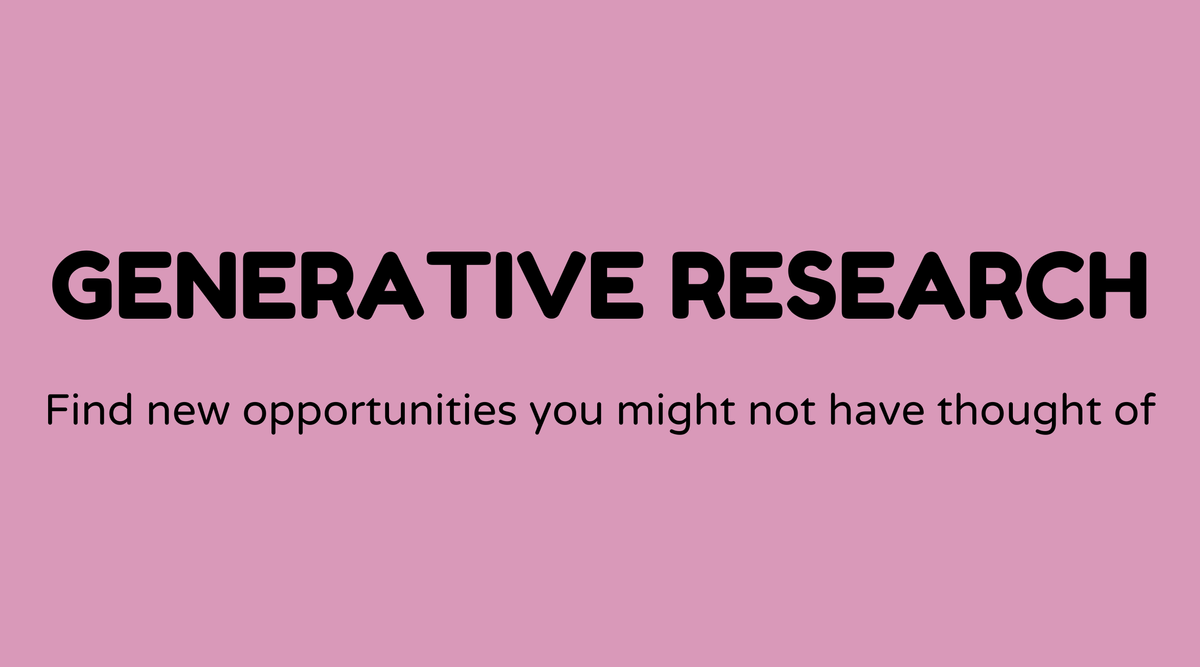Generative research

Overview of Generative Research:
Generative research is essential for grasping users' needs, preferences, and behaviors in the initial stages of product development. It offers rich qualitative insights that help shape products or services that resonate with target audiences. If you've ever wondered how brands seem to understand precisely what you want, generative research is likely the hidden factor behind their customer-centered strategies.
This type of research involves thorough exploratory studies where researchers often interact directly with consumers through interviews, focus groups, and observations. Such insights guide the creation and refinement of user-centered designs, ensure relevance, and ultimately improve product success. You'll find it playing an integral role in UX design, marketing strategies, and innovation.
Why Generative Research Matters:
So, why is generative research such a prominent topic? In simple terms, it connects designers and users, promoting a nuanced understanding of end-user contexts. This leads to products that aren’t just functional but also enjoyable and fulfilling.
Consider it a treasure trove of information that helps avert costly design errors, optimizes creative solutions, and aligns company offerings with market demands. Furthermore, generative research builds empathy with users, which is foundational for any effective design thinking process.
What is Generative Research:
Generative research refers to methodologies that inspire and inform the design process. Unlike evaluative research, which assesses existing concepts, generative research is exploratory at its core. It seeks to reveal user needs and desires that aren’t immediately apparent, providing a basis of insightful information.
A key practice involves gathering qualitative data through user interviews, participatory design sessions, ethnography, and co-design workshops. This research aids teams in formulating hypotheses and conceptualizing ideas before focusing them into specific design solutions.
How do you do Generative Research:
Starting with generative research can feel quite daunting, but here's a straightforward approach:
-
Define Objectives: Clearly articulate what you want to understand and how these insights will assist in decision-making.
-
Select Methods: Choose qualitative techniques such as contextual inquiry, diary studies, or workshops that best suit your objectives.
-
Recruit Participants: Pick a diverse range of participants who represent your target market or have a vested interest in your product area.
-
Collect Data: Engage with participants in natural settings and encourage open-ended discussions to gather rich, detailed information.
-
Analyze Data: Identify patterns and themes among the responses to form user personas and journey maps.
-
Synthesize Insights: Transform findings into actionable insights and design imperatives that inspire ideation sessions.
Examples of Generative Research:
Let’s look at some real-world examples where generative research has been essential:
-
Airbnb: The company frequently uses generative research to delve into travelers' pain points and experiences, informing features like flexible booking options.
-
Apple: Their product development heavily invests in understanding user lifestyles, as seen with the innovative launch of user-centered gadgets like the iPhone.
-
IKEA: Conducts home visits to gain user insights, resulting in designs that reflect various global living situations.
These examples illustrate how businesses utilize generative research to create solutions that are not only innovative but well-received by users.
Sample Agenda of Generative Research Workshop:
- Introduction & Warm-Up (15 mins): Brief overview of purpose and goals.
- Contextual Inquiry (45 mins): Users share experiences related to the product domain.
- Ideation Session (60 mins): Collaboratively brainstorm potential solutions.
- Break (15 mins).
- Prototyping Activity (60 mins): Participants sketch or model their ideas.
- Feedback & Discussion (30 mins): Gather feedback on ideas and insights.
FAQs
What distinguishes generative research from evaluative research?
Generative research focuses on creating possibilities and gaining a deeper understanding of user contexts, while evaluative research tests assumptions and prototypes to validate design decisions.
Can generative research be quantitative?
Primarily, it is qualitative, although quantitative insights can emerge from trends identified during initial generative phases.
How long does generative research typically take?
It varies but usually spans a few weeks to a couple of months, depending on the project's scope and complexity.
How can small businesses leverage generative research?
By engaging directly with a small yet diverse group of users through interviews or participatory design sessions, even small businesses can gain valuable insights.
What tools facilitate generative research?
Tools like Miro or Mural for online workshops, Otter.ai for transcription, and Zoom for interviews can help facilitate effective generative research.
Is generative research suitable for all product types?
Certainly. Whether digital, physical, or service-based, generative research reveals insights applicable across various product types and industries.



